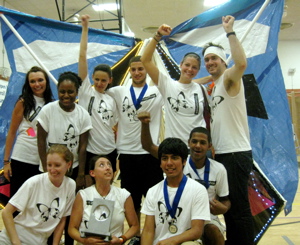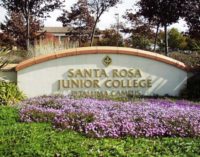Teams of budding and seasoned architects faced off last week for the second annual Iron Designer Challenge, where they constructed freestanding “Portals”—structures that mediate two spaces—in less than three hours.


The Gensler team won the 2010 contest, in which participants built emergency shelters, and once again, it took home the grand prize. Inspired by a metamorphosis theme, the team wrapped a cocoon structure in adjustable flaps that opened to mimic the spread of a butterfly’s wings. PVC piping was the primary construction material, allowing the joints of the wings—wrapped in colorful duct tape—to pivot open and shut.
The June 9 competition, featuring eight teams of three high school students and four professionals, was organized by the School of Design and Construction (SDC), a public high school in Midtown Manhattan offering classes in design, construction, architecture, and engineering. Opened in 2004, the SDC is part of a consortium of 21 middle and high schools throughout New York City managed by The Urban Assembly, a nonprofit organization focused on college preparation for underprivileged students.
During the Iron Designer Challenge, rain forced the competitors to relocate from SDC’s rooftop to the gymnasium. Despite stifling heat in the gym, the teams stayed animated. “I think we’re having a fun time—we’re building a butterfly for God’s sake,” said Gensler architect Adam Quinn, who had cut off the sleeves on his custom-made “Metamorphosis” team T-shirt and was wearing the extra cloth as a sweatband. “You crawl in on your belly and then you stand up and spread your wings.”
The guidelines for the competition—as well as the assignment of wood, plastic, or cardboard as a primary construction material—were released last month to allow the teams to hone their designs. However, competitors were granted access to the building materials only after the clock started running. After 90 minutes, each team received a “secret material”—a string of lights—to incorporate in its final design.
In addition to Gensler, professionals from the firms Cerami & Associates, Northern Bay Contractors, Omni Architects, Parsons Brinckerhoff, Robert Silman Associates, Thornton Tomasetti, and Turner participated in the competition. Student team members said the experience gave them a chance to see the inner workings of a firm. “Every Wednesday, we got out of school early and the team went to the firm,” said Joshua Tavarez, a Gensler team member and junior at SDC. “We usually received a small homework assignment—stuff to think about for the next week.”
In addition to Gensler, the concept of transformation figured into other teams’ designs. Isamar Jimenez, a member of the Turner team that built an Amazonian-style plank out of bamboo, said her team’s design was based on the idea that a portal is a space for making choices on an “unsure path.” “It started with the whole Peter Pan thing—the choice to remain a kid or become an adult,” said Jimenez, a SDC senior who hopes to study international business in college next year. “A portal is about transformation and change.” “When we started, we were just throwing ideas out there,” added Eric Davila, also a senior and a member of the Turner team. “We focused on both the structural and creative aspects.”
Also working with the idea of change, the Robert Silman Associates team built a time capsule featuring a giant cardboard clock. The team members dressed as icons from pre- and post-industrial history, including a caveman, the Statue of Liberty, and Rosie the Riveter. “Like the monocle I am sporting, engineering is a wonderful medium through which to see the past and present of our journey through civilization,” said Tim Bowden, a structural engineer dressed as John D. Rockefeller.
The professional team members said they were impressed with their younger counterparts. “They’re a lot smarter than I was at that age,” said David Lee, who works at Omni Architects and whose team built a maze-like pathway charting the turns and twists of life. “The students really thought outside the box for us.”



Post a comment to this article
Report Abusive Comment